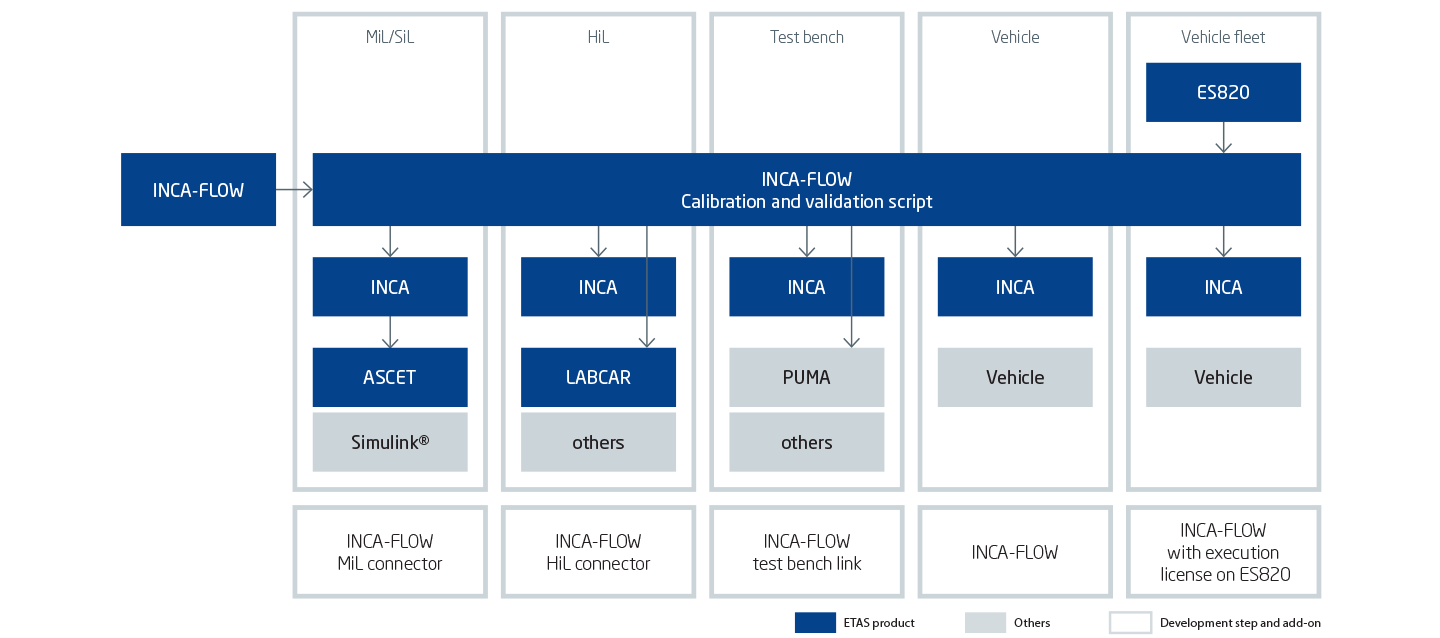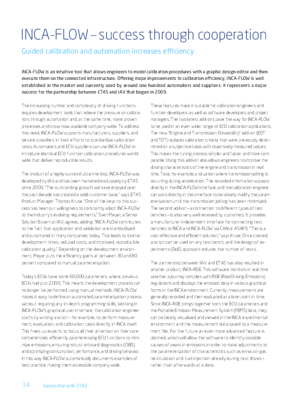INCA-FLOW – success through cooperation
Guided calibration and automation increases efficiency

INCA-FLOW is an intuitive tool that allows engineers to model calibration procedures with a graphic design editor and then execute them on the connected infrastructure. Offering major improvements to calibration efficiency, INCA-FLOW is well established in the market and currently used by around one hundred automakers and suppliers. It represents a major success for the partnership between ETAS and IAV that began in 2009.
The increasing number and complexity of driving functions requires development tools that relieve the pressure on calibrators through automation and, at the same time, make proven processes and know-how available company-wide. To address this need, INCA-FLOW supports manufacturers, suppliers, and service providers in their efforts to standardize calibration tasks. Automakers and ECU suppliers can use INCA-FLOW to introduce identical ECU function calibration procedures worldwide that deliver reproducible results.
The product of a highly successful partnership, INCA-FLOW was developed by IAV and has been marketed exclusively by ETAS since 2009. “The outstanding growth we have enjoyed over the past decade has created a solid customer base,” says ETAS Product Manager Thomas Kruse. “One of the keys to this success has been our willingness to constantly adapt INCA-FLOW to the industry’s evolving requirements.” Sven Meyer, a Senior Solution Expert at IAV, agrees, adding: “INCA-FLOW contributes to the fact that application and validation are standardized and automated in many companies today. This leads to shorter development times, reduced costs, and improved, reproducible calibration quality.” Depending on the development environment, Meyer puts the efficiency gains at between 30 and 80 percent compared to manual parameterization.
Today’s ECUs have some 60,000 parameters, where previous ECUs had just 2,000. This means the development process can no longer be performed using manual methods. INCA-FLOW makes it easy to define an automated parameterization process without requiring any in-depth programming skills. Working in INCA-FLOW’s graphical user interface, the calibration engineer starts by writing a script – for example, to perform measurement, evaluation, and calibration tasks directly in INCA itself. This frees up experts to focus all their attention on their core competencies: efficiently parameterizing ECU functions to minimize emissions, ensuring robust onboard diagnostics (OBD), and optimizing consumption, performance, and driving behavior. In this way INCA-FLOW automatically documents examples of best practice, making them accessible company-wide.
These features make it suitable for calibration engineers and function developers as well as software developers and project managers. The two latest add-ons pave the way for INCA-FLOW to be used in an even wider range of ECU calibration applications. The new “Engine and Transmission Driveability“ add-on (EDT and TDT) replaces calibration criteria that were previously determined on a subjective basis with objectively measured values. This makes the tuning process simpler and faster and more comparable. Using this add-on also allows engineers to improve the driving characteristics of the engine and transmission in real time. Take, for example, a situation where transmission jolting is occurring during acceleration. The recorded information appears directly in the INCA-FLOW interface, and the calibration engineer can work directly in this interface to iteratively modify the parameterization until the transmission jolting has been minimized.
The second add-on – a connection to different types of test benches – is also very well received by customers. It provides a manufacturer-independent interface for connecting test benches to INCA and INCA-FLOW via CAN or ASAP3. “This is a cost-effective and efficient solution,” says Kruse. Once created, a script can be used on any test bench, and the design of experiments (DoE) approach reduces the number of tests.
The partnership between IAV and ETAS has also resulted in another product, INCA-RDE. This software monitors in real time whether a journey complies with RDE (Real Driving Emissions) regulations and displays the emission data in various graphical forms in the INCA environment. Currently, measurements are generally recorded and then evaluated at a later point in time. Since INCA-RDE brings together both the ECU parameters and the Portable Emission Measurement System (PEMS) data, they can be clearly visualized and viewed in the INCA experimental environment and the measurement data saved to a measurement file. For the future an even more advanced feature is planned, which will allow the software to identify possible causes of peaks in emissions in order to make adjustments to the parameterization of characteristics such as exhaust-gas recirculation and fuel injection already during test drives – rather than afterwards at a desk.
Summary
The partnership between IAV and ETAS is a genuine success story. INCA-FLOW is already firmly established in the market – and the launch of INCA-RDE means customers now have access to another product that offers equally impressive benefits. By boosting efficiency, both tools considerably make automotive developers’ work easier and thus strongly meet customer requirements.
Author
Axel Heizmann is Senior Marketing Communications Manager at ETAS GmbH.

